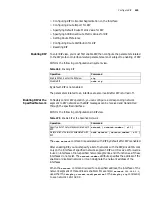
414
C
HAPTER
28: C
ONFIGURING
RIP
The procedure of running RIP can be described as follows:
1
When a specific router is starting RIP for the first time, it broadcasts request
messages to the neighbor routers. After receiving the request messages, the
neighbor routers respond to the request and return response messages including
local routing information.
2
After receiving the response message, the router modifies the local routing table
and sends triggered modified messages to the neighboring routers by
broadcasting the route modification information. After receiving the triggered
modified message, the neighboring routers forward them to their neighbors. After
a series of triggered modification broadcasting, all routers can receive and
maintain the latest routing information.
3
At the same time, RIP broadcasts the local routing table to the neighbor routers
every 30 seconds. The neighbor routers receive the message and maintain the
local routes. Then they select the best route to broadcast the route modification
information to their neighbor networks. In this way, the updated routing
information can be globally effective. Also, RIP applies a timeout mechanism to
dispose of an outdated route and to make sure that the route is real-time and
effective.
Though RIP is widely used by most of the router manufacturers, it has limitations:
■
It supports a very limited number of routers: RIP is only suitable to small
autonomous systems, such as most campus networks and local networks with
simple structure and high continuity.
■
The route calculations depend on a fixed metric: RIP cannot update its metric in
real time to adapt to network changes. The metric defined by an administrator
remains constant until it is updated artificially.
■
It may cost considerable network bandwidth to update its information: RIP
broadcasts an update message every 30 seconds so it may cause low efficiency
in a network with a lot of nodes.
Configure RIP
Begin all configuration tasks by first enabling the RIP routing process and
associating a network with an RIP routing process, then configure other functional
features related to RIP protocol. The task of configuring the interface-related
features is not subject to whether RIP has been enabled.
The original interface parameters become invalid after the RIP is closed.
Configuring RIP includes tasks described in the following sections:
■
Enabling RIP
■
Enabling RIP at the Specified Network
■
Defining a Neighboring Router
■
Specifying RIP Version
■
Configuring Check Zero Field of RIP Version 1
■
Specifying the Status of an Interface
■
Disabling Host Routes
■
Enabling Route Summarization for RIP Version 2
■
Configuring RIP-2 Packet Authentication on the Interface
Summary of Contents for 3036
Page 1: ...http www 3com com 3Com Router Configuration Guide Published March 2004 Part No 10014299 ...
Page 4: ...VPN 615 RELIABILITY 665 QOS 681 DIAL UP 721 ...
Page 6: ...2 ABOUT THIS GUIDE ...
Page 7: ...I GETTING STARTED Chapter 1 3Com Router Introduction Chapter 2 3Com Router User Interface ...
Page 8: ...4 ...
Page 16: ...12 CHAPTER 1 3COM ROUTER INTRODUCTION ...
Page 34: ...30 ...
Page 60: ...56 CHAPTER 3 SYSTEM MANAGEMENT ...
Page 98: ...94 CHAPTER 6 DISPLAY AND DEBUGGING TOOLS ...
Page 110: ...106 ...
Page 114: ...110 CHAPTER 8 INTERFACE CONFIGURATION OVERVIEW ...
Page 158: ...154 CHAPTER 10 CONFIGURING WAN INTERFACE ...
Page 168: ...164 ...
Page 188: ...184 CHAPTER 13 CONFIGURING PPPOE CLIENT ...
Page 192: ...188 CHAPTER 14 CONFIGURING SLIP Router ip route static 0 0 0 0 0 0 0 0 10 110 0 1 ...
Page 248: ...244 CHAPTER 16 CONFIGURING LAPB AND X 25 ...
Page 320: ...316 ...
Page 330: ...326 CHAPTER 20 CONFIGURING IP ADDRESS ...
Page 362: ...358 CHAPTER 21 CONFIGURING IP APPLICATION ...
Page 374: ...370 CHAPTER 23 CONFIGURING IP COUNT ...
Page 406: ...402 CHAPTER 25 CONFIGURING DLSW ...
Page 408: ...404 ...
Page 452: ...448 CHAPTER 29 CONFIGURING OSPF ...
Page 482: ...478 CHAPTER 30 CONFIGURING BGP ...
Page 494: ...490 CHAPTER 31 CONFIGURING IP ROUTING POLICY ...
Page 502: ...498 ...
Page 508: ...504 CHAPTER 33 IP MULTICAST ...
Page 514: ...510 CHAPTER 34 CONFIGURING IGMP ...
Page 526: ...522 CHAPTER 36 CONFIGURING PIM SM ...
Page 528: ...524 ...
Page 532: ...528 CHAPTER 37 CONFIGURING TERMINAL ACCESS SECURITY ...
Page 550: ...546 CHAPTER 38 CONFIGURING AAA AND RADIUS PROTOCOL ...
Page 590: ...586 CHAPTER 40 CONFIGURING IPSEC ...
Page 599: ...IX VPN Chapter 42 Configuring VPN Chapter 43 Configuring L2TP Chapter 44 Configuring GRE ...
Page 600: ...596 ...
Page 638: ...634 CHAPTER 43 CONFIGURING L2TP ...
Page 649: ...X RELIABILITY Chapter 45 Configuring a Standby Center Chapter 46 Configuring VRRP ...
Page 650: ...646 ...
Page 666: ...662 ...
Page 670: ...666 CHAPTER 47 QOS OVERVIEW ...
Page 700: ...696 CHAPTER 49 CONGESTION MANAGEMENT ...
Page 706: ...702 CHAPTER 50 CONGESTION AVOIDANCE ...
Page 707: ...XII DIAL UP Chapter 51 Configuring DCC Chapter 52 Configuring Modem ...
Page 708: ...704 ...
Page 762: ...758 CHAPTER 52 CONFIGURING MODEM ...















































